Swimming Upstream
Tess Joosse reports on the race to rescue and recover a dwindling coho salmon population after a cataclysmic wildfire. Illustrations by Sophie Wood Brinker and Kylie Kathleen Smith.
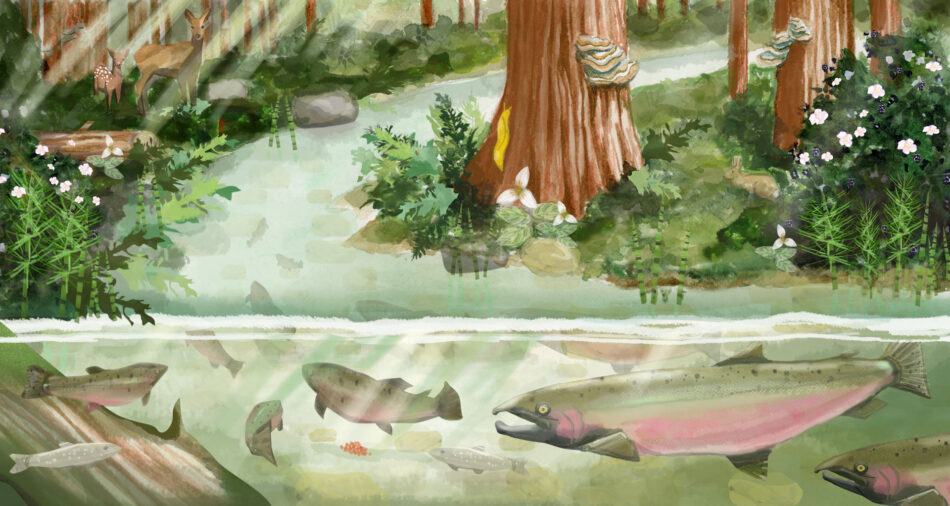
Later, when the flames were gone but the ground was still smoldering, a team from the Kingfisher Flat Hatchery 16 miles north of Santa Cruz on the California coast returned to survey the damage. They found that the fire had not only destroyed the fish tank; it had also disrupted water flows to nearby pools stocked with 60,000 salmon fry. Half of the baby fish lay lifeless in the water, suffocated.
The team picked through the piles of ash and contorted hardware to tally up the fish carcasses, finding 112 dead Coho strewn around the burst tank. “One of them got away,” says Mathers Rowley, with an incredulous laugh.
Rowley, the Chair of the nonprofit Monterey Bay Salmon and Trout Project, which oversees the hatchery, wears a plaid shirt, brown boots, and a tired smile. He looks over at what’s left of the tank, then up at the steep, charred hillsides. Six months after the fire the earth still looks wounded, blackened stumps and branches sticking up out of the dirt. Between here and the creek is a jumble of downed trees and debris. It’s hard to imagine the wayward fish could have made it very far. But maybe.
When the CZU Lightning Complex wildfire ripped through the Santa Cruz Mountains in August 2020 it burned hot and fast, tearing up 86,500 acres that stretched from dense redwood forests right to the edge of the coast. Now, as the Kingfisher Flat Hatchery looks to rebuild, researchers are trying to understand how the fallout from the fires will affect the area’s population of Central California Coast Coho salmon. This hatchery is one of just two facilities working to recover these endangered fish.
Heavy winter rains will wash burn debris down into the watershed, altering water quality, habitat, and food sources in the streams where these delicate fish swim and spawn. This population of Coho is at risk of extinction — they’re one of the nine most endangered aquatic species in the United States, according to the National Oceanic and Atmospheric Administration’s Fisheries Service. All salmonid fish are anchors in both the fresh and salt waters they swim in throughout their life cycles. “Salmon help an entire ecosystem,” says Erin Seghesio, a biologist with NOAA Fisheries. “Restoring salmon helps restore the whole environment.”
The 2020 wildfire season on the West Coast of the United States was one of the worst in recorded history. Estimates put the total area burned in Washington, Oregon, and California at over 6 million acres; other metrics of damage are harder to quantify. Bears, cougars, birds, insects — perhaps thousands of terrestrial and arboreal species lost important habitat. And aquatic animals were not spared. Chemicals and metals from burning structures seeped into waterways and into fishes’ bodies. Anything that’s burned within the vicinity of a watershed — like earth, plants, and buildings — can wash down into a creek with just a few inches of hard rain, disrupting the stream ecosystem for months or even years after the fire is extinguished.
Even before 2020, Pacific salmon faced a unique combination of threats due to their unique life cycles. Born in freshwater, salmon go to the ocean as adolescents to fatten up. When they’re sexually mature, the fish return to the streams where they were born to spawn and die. How salmon know where to return to is the stuff of folklore; scientists think they use Earth’s magnetic field and their sense of smell to make it back home. When Rowley describes young Coho preparing to leave their hatchery for the Pacific Ocean, he makes an exaggerated sniffing noise to mime the fish taking in the scent of their home waters. “Then they head out to the ocean,” he says.
Coho spawned in California might travel as far north as the Gulf of Alaska, Rowley says, looking for food in cool waters. But the ocean is warming at an alarming rate, and freshwaters are too. Climate change is pushing Pacific salmon to the brink on both fronts, scientists say, but the endangered central California coast Coho might be well poised to respond to the warming. They’re some of the southernmost salmon on the West Coast, with a range extending 250 miles between the Monterey Bay and Punta Gorda in northern California. It’s important to preserve their genetics as the planet gets hotter, says Seghesio.
The verdant Big Creek site has been used as a hatchery for Coho and steelhead, Coho’s hardier cousin, off and on since 1927. To respond to the rapidly dwindling Coho numbers in central California, NOAA Fisheries and the state Department of Fish and Wildlife created a conservation and recovery program in 2002, bringing the small Kingfisher Flat Hatchery to raise, breed, and release Coho. And not a moment too late, scientists say. Without the intervention, Coho were likely to blink out south of the Golden Gate, and the genetics that existed there would have been lost.
“Restoring salmon helps restore the whole environment.”
Burn, rinse, repeat
A hulking Toyota Tundra gently hugs the curved roads as it winds away from town and into the mountains behind Santa Cruz. The cup holders are overflowing with random rocks and pebbles picked up from field research outings, and they clink together with each turn of the truck. Nice detail. We’re on our way to the burn area that sits upstream of Scott Creek, to collect sediment that will inevitably wash down into the Coho habitat the next time it rains. Christina Richardson, a hydrologist at the University of California, Santa Cruz, sits in the passenger seat; the driver, a graduate student named Maya Montalvo, kills the engine and hops out into the early morning mist.
On the left side of the road lies just a slice of the CZU Lightning Complex Fire burn scar. It’s been nearly half a year since 11,000 bolts of lightning lit up the night sky and struck the bone-dry Santa Cruz mountains in a magnificent, terrifying display. Those blazes painted this mountain range with angry orange flames for five weeks, killing one person, injuring another, and destroying 1,490 buildings.
This portion of the burn area slopes downward, revealing a vista of layered conifers. Underfoot, it’s a mess of ashy dirt, charred pinecones, crumbling sticks, and shards of tan-pink rock that Montalvo says is quartz. Richardson crouches down to scrape some soil off the ground and into a plastic baggie. “Ash, soil, redwood needles, we take it all and bake it in the oven at a low temp to dry it out,” she explains as she seals the bag. “Then it gets thrown in an instrument that combusts it.” The machine will tell her the carbon and nitrogen makeup of each sample, data that could be meaningful if these soils up on the hillsides wash down into the watershed the next time it rains.
The sediment that ends up down in Scott Creek will churn and settle in the creek bed, disrupting the endangered Coho salmon’s habitat. Coho like crystal-clear streams with lots of nooks and crannies, where they lay their eggs, hide from predators, and search for food. Tasty, microscopic swimming insects prefer these tight spaces. If an influx of sediment plugs up those many cracks and crevices, the Coho and their prey will lose their preferred hiding spots.
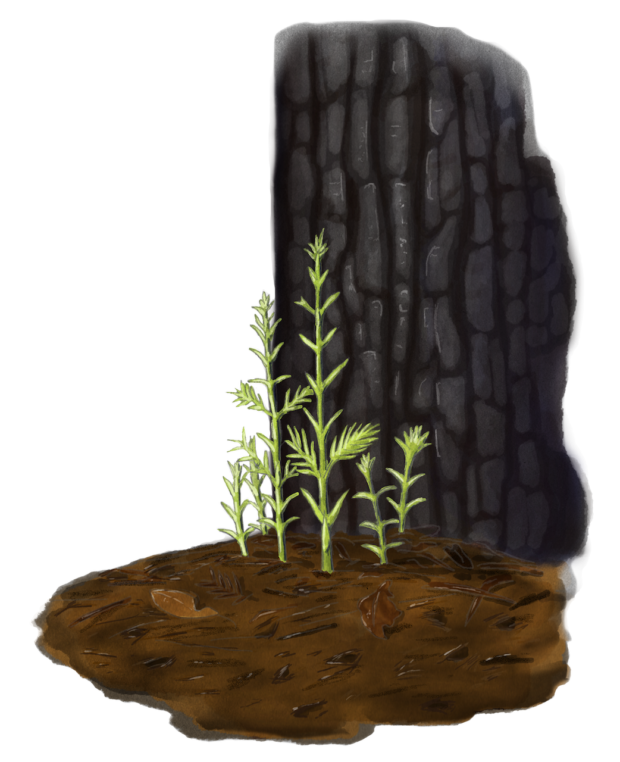
Six months after the CZU Lightning Complex Wildfire, new regrowth is visible among the charred redwoods. Credit: Kylie Kathleen Smith
It’s been a dry winter so far, but up to ten inches of rain are expected next week. Such an intense rainfall — the first of the season — could wreak serious havoc, pulling fire debris down the mountains, posing risks to both Coho and humans. (Indeed, the weekend after our visit, a mudslide swept a 150-foot chunk of iconic Highway 1 down into the ocean near Big Sur). The physical properties of earth change after fire, Richardson explains. Not only has the soil been stripped of the live trees and bushes that might act as roadblocks to free falling debris, but the remaining dirt gets covered by a film-like coating that prevents rain from permeating the ground. “Imagine a water drop on a leaf, right? If just kind of gels up,” she says. “It’s like that for rainfall events. It just doesn’t really sink in.” As we look out over the scarred landscape, the light mist turns into a drizzle.
When the heavy rains do come a few days later, Richardson, Montalvo and their colleagues head down into the watershed. The scientists toss probes into the rushing water to read its salinity, pH, temperature, conductivity, and dissolved oxygen content. They dunk giant Nalgene jugs into the surging water and bring the contents back to the lab to filter and analyze for the same elemental makeup as the dry samples. To get a sense for how much burned material has made its way down the watershed, Richardson also specifically measures how much carbon in the stream came from a combusted source. Where the stream once ran clear, now it looks like frothy chocolate milk.
Trickling out
This burn-flood cycle has been occurring for millions of years, and California’s flora and fauna evolved to withstand or respond to it. For centuries, indigenous Californians, including Ohlone peoples in the Bay Area, managed the landscape with fire, setting controlled burns to clear away dead matter and usher in new plant growth. “Humans and nature have been partners in that for a long time,” says Mark Hylkema, an archaeologist and Tribal liaison with the California Department of Parks and Recreation. These controlled burns did introduce sediments into the watersheds, he says, as did any natural blazes that occurred. But their impact wasn’t cataclysmic, since they were small fires by design. European colonizers put a stop to the practice when they forcibly removed native people from the land. Over the years, a glut of dead fuels built up in the understory, providing a hungry spark with enough sustenance to grow into immense blazes.
The influx of colonizers also put a squeeze on the Coho. Fishermen started snatching them up, and development narrowed suitable salmon habitat from the late 1800s onward in central California. Pools and side streams were filled in or straightened out by logging operations and settlers tapped rivers to divert water for agriculture, leaving water that’s often too warm for the picky fish. “They’re probably the most sensitive of all the salmonids,” says Joel Casagrande, a biologist with NOAA Fisheries. “So as the habitat unraveled, and you start to get lower numbers, ecological events have more of a consequence.”
For instance, droughts in the 1970s and 1980s prevented sandbars at the mouths of coastal creeks from opening, blocking returning fish from accessing their home streams to spawn. The warming ocean tightened the stranglehold on the salmon, and by the late 1990s the population on the central California coast was on the verge of extinction. The recovery program was created in the early 2000’s, and in 2005 the Coho was officially listed as endangered under the Endangered Species Act.
A main pillar of the Coho recovery effort is the captive broodstock program, which aims to both diversify the Coho gene pool and retain the unique genetics of the population . Coho raised in the hatchery are selected by scientists to breed in meticulously selected pairings, says Seghesio, who is NOAA’s recovery coordinator for the Coho. “Every fish is genotyped,” she says. Then, geneticists pick up to four males to cross to a female. “You wouldn’t want to just put one female with one male, because what if that one male ended up having sperm that didn’t work? So, you spread out their potential, and you’re also creating different types of cross-related fish.” More diverse genetics equals fitter fish, who themselves are more likely to successfully spawn and pass their genes down to their descendants.
At the Kingfisher Flat Hatchery, these crosses happen in a low-slung, wood-sided building. Under dim lights and cool air, translucent orange eggs are incubated in successive tubs and troughs. Once they hatch, the fry are either reared for release or designated to replenish the breeders that die immediately after laying eggs. Half of this captive broodstock group is kept in a vessel off a tributary of the San Lorenzo river, away from the main hatchery site. The other half was kept on the side of Big Creek in a shaded tank, until they perished in the CZU Lightning Complex Fire.
“It could have been so much worse”
“It was a pretty big hit,” says Joe Kiernan, an ecologist with NOAA’s Southwest Fisheries Science Center who works on Central California Coast Coho recovery. Kiernan and his colleagues are now trying to piece the program back together with the fish that did survive the fire at the hatchery. “Salmon is all about numbers. You have to put a lot of fish out to get fish back, and anything that creates a bottleneck, like the fire in this case, you know, that’s tough.”
Even before the losses sustained in 2020, the number very few fish return to Scott Creek. In a typical year, the program releases up to 35,000 smolt fish, with high hopes that two percent, or 700 adults, come back to spawn. In reality, only a couple return. All the multitude of factors that put Coho on the endangered species list in the first place are to blame, he explains. “It’s just tough to be a salmon in central California.”
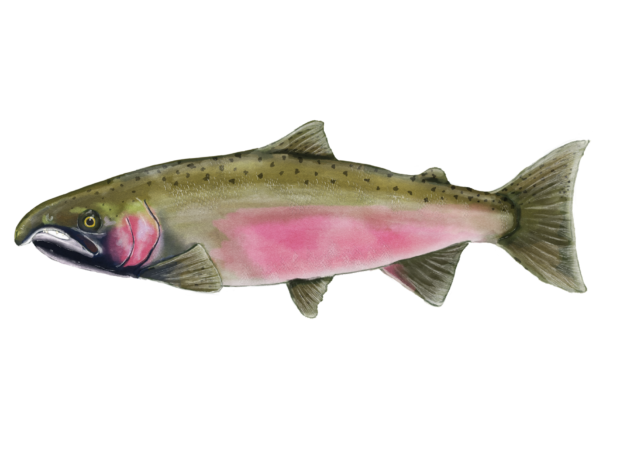
Only a handful of adult Central California Coast Coho salmon return to spawn in Scott Creek each year. Credit: Kylie Kathleen Smith
After the smoke cleared, the team determined they couldn’t leave the surviving fish down at the Kingfisher Flat hatchery, so they cobbled together a makeshift solution. “We scrambled,” Kiernan says. They remodeled the aquarium room at the UC Santa Cruz Coastal Campus, creating makeshift holding pens and configuring plumbing to accommodate the fish. But the setup started to overload the facility’s filtration system, so in the late fall the team tagged and released 10,000 smolt in Pescadero Creek, about 25 miles north of Scott Creek.
Despite the casualties, Kiernan is optimistic. “I have to be,” he says. Several years ago, the team decided to separate the captive broodstock cohort between two separate locations, one at Kingfisher Flat and another site to the east, in anticipation of this type of disaster. Otherwise, all of the program’s spawning stock would have been lost. “I feel fortunate that we didn’t lose everything, right?” Kiernan says. “It could have been so much worse.”
After the fire
The burned hatchery also faces a steep uphill climb; to repair the damage, the Monterey Bay Salmon and Trout Project will need to fundraise hundreds of thousands of dollars. But before rebuilding can even begin, the site still needs to be cleared of debris. Two bridges that provide access to the hatchery and several neighboring houses burned down, leaving the hatchery unreachable by automobile.
“And I have concerns that extend beyond the hatchery itself,” says Mark E. Galloway, who managed the hatchery until the fire. He worries about the conditions of the watershed, and the fallout from the burn scar that could still damage the hatchery site.
Boyhood fishing trips with his dad first piqued Galloway’s interest in rivers and streams. He got a degree in fisheries biology and worked in hatcheries all his life before coming to Kingfisher Flat in 2011, two years after the much smaller Lockheed Fire in the area. Galloway lived with his wife in a house just a few hundred yards downstream of the hatchery and oversaw daily operations at the facility.
As the CZU fire erupted over the nearby hills on the evening of August 18, 2020, glowing embers fell through the air like fireflies, landing around Galloway’s house. He wasn’t surprised to when he got the call to evacuate just before midnight. Galloway and his wife packed up the car and made their way out of the canyon, alongside their friends and neighbors. “It was a surreal experience. It was rather calm; I don’t know if because folks had gone through the Lockheed incident 10 years earlier, or if they thought they would be returning in a matter of days.”
That wouldn’t happen for Galloway; his house was completely destroyed. He and his wife now live in Washington state, but Galloway has returned to the hatchery in the months since to take stock of the damage. He says he was shocked by how the fire seemed to scrape all signs of life from the landscape. “I’d walk up to some secluded canyons and you would hear nothing. No bird songs … nothing. That was very disturbing to me. That’s all gone.”
Despite all the losses, there’s no plan yet to abandon Coho restoration in the Santa Cruz mountains. All the program’s partners— federal and state agencies, the nonprofit, and the scientists — think it’s too important to walk away from, Galloway says. “The fire did what it did, but nobody’s giving up.”
But why bother? Why put so much time, space, money, blood, sweat, and tears into saving a group within a group of salmon, a population that’s already at the furthest reaches of its historical range, and on what some might describe as its last leg? There are economic answers — while the area’s Coho aren’t fished for profit, many say that their mere presence is valuable, and makes people interested in visiting the area. There are recreational ones — angling, scouting, and nature-interpretation opportunities abound when Coho are around.
And Coho are an essential part of a dynamic and interconnected ecosystem. Whenever they eat, get eaten, defecate, spawn, die, and decompose, they’re part of an equation, working in concert with the whole natural world around them. “Take out a part of that equation, and there are unforeseen consequences,” Galloway says.
Perhaps in order for the rest of the world to work, for water to be clean and air to be clear, there need to be Coho salmon in Central California, Galloway says: “These fish were here for a reason. And there may be reasons we have left to find out.”
© 2021 Tess Joosse / UC Santa Cruz Science Communication Program
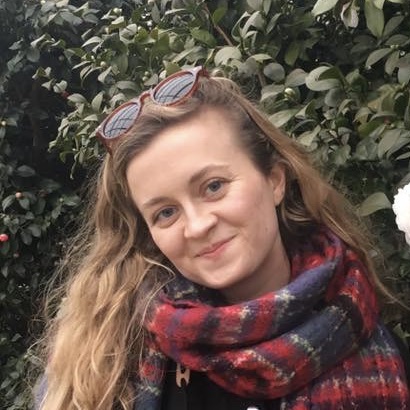
Tess Joosse
Author
B.A. (biology) Oberlin College
Internships: Inside Science, Science, The Mercury News, Scientific American, Smithsonian National Museum of Natural History
We were building sandcastles on a windswept Michigan beach when I asked my parents where all the water in front of us went. To my surprise, they told me that the water in Lake Michigan flowed for hundreds of miles, all the way to our home in Chicago. Sensing my budding curiosity, they later gave me a placemat with a map of the world on it. I spent countless meals studying the map, one hand grasping my fork and the other hand tracing the lines of the Earth. It amazed me how all these dots and shapes represented borders and mountains, lakes and rivers, and cities where millions of people lived their lives. I’m still marveling at the complex and beautiful world in front of me; now I share my curiosity with others through my work as a science journalist.
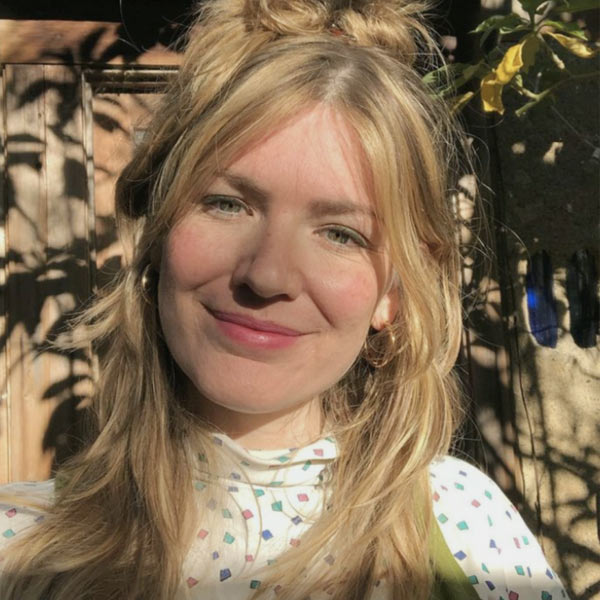
Sophie Wood Brinker
Illustrator
Certificate in graphic design, University of California, Berkeley
Internships: Santa Cruz Museum of Natural History, Sweet Roots Farm
Sophie Wood Brinker (she/her) is an Illustrator who concentrates on appreciation of the small + care of human and non-human neighbors. She grew up in Santa Cruz, California, on Awaswas-speaking Uypi land, where she found endless inspiration in the flora and fauna of the central coast. Sophie has a BA in Peace and Global Studies from Earlham College, as well as a Certificate in Graphic Design from UC Berkeley. She is grateful to have spent this last year as a student of the Science Illustration Program at Monterey State, where she has furthered her passion for creating images as a means of connection. Through watercolor, pencil, and ink, Sophie communicates the brilliance and intricacy of the ecosystems that surround us. She currently lives in Bolinas, California, on Coast Miwok land.
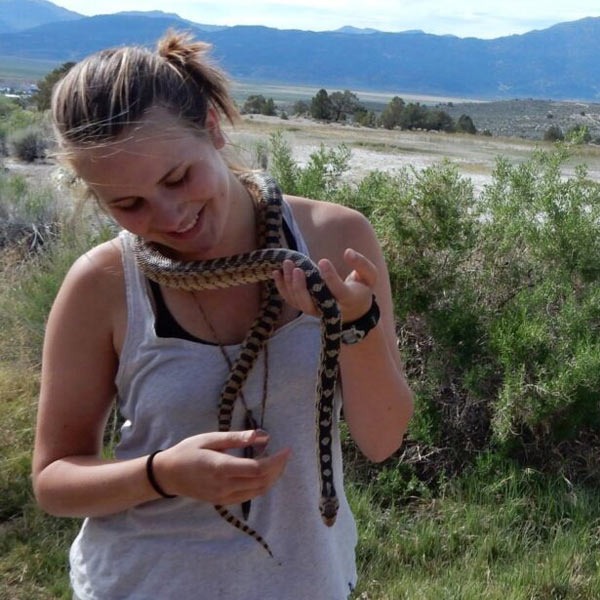
Kylie Kathleen Smith
Illustrator
Internship: Oikonos Ecosystem Knowledge
My curiosity for the natural world was stoked by an immersive field course in college during which I observed, sketched, and studied the diverse ecosystems throughout California. I discovered that I learn best when dirt, sand, and rock are beneath my feet. This course fueled my desire to become a lifelong student of natural history, and to use my art as a tool for sharing information about the natural world with others. In my quest for knowledge, I’ve worked as a field tech helping to protect California Condors, led hundreds of students and adults in experiential learning on land and water, and taught others about how to use field sketching as a tool for learning and connecting with nature. Through these various positions as a science communicator and educator, I’ve seen how valuable a personal connection to nature is for people in an ever-disconnected world. I aim to create art that can help nature be more accessible and help to foster a connection between people and the world around us.